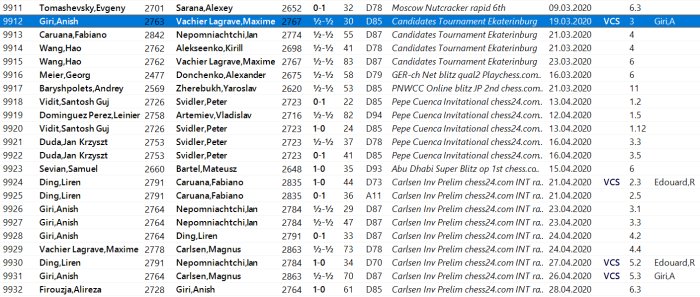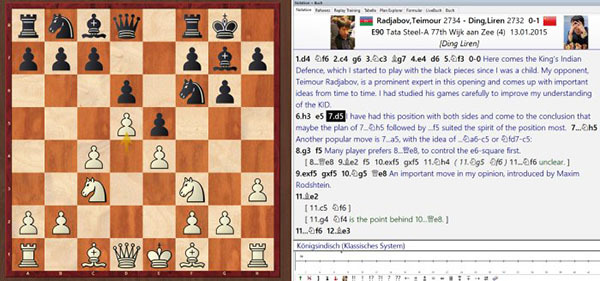In this video course, the Austrian number 1 and Grünfeld expert Markus Ragger gives you the necessary knowledge to outplay your opponents with the Grünfeld. In over 10 hours (volumes 1 and 2), he presents the most important main and side lines. Subsequently, you have the chance to apply your freshly acquired knowledge in interactive video format, finding the right moves in response to the author’s questions. What’s more, you can practice the repertoire and play out the Grünfeld structures against the computer. So - start studying the Grünfeld right away!
1.d4 Nf6 2.c4 g6 3.Nc3 d5 4.cxd5 Nxd5
- 5.Bd2, 5.g3, 5.Na4, 5.Qb3/Qa4
5.e4 Nxc3 6.bxc3 Bg7
- 7.Ba3, 7.Bc4, 7.Be3, 7.Bb5, 7.Qa4, 7.Bg5
7.Nf3 c5
- 8.Rb1, 8.Be2, 8.h3, 8.Bb5, 8.Be3
• Video running time: 5 hours (English)
• With interactive training including video feedback
• Extra: Training with ChessBase apps - Memorize the opening repertoire and play key positions against Fritz on various levels
• Database with model games
Power openings: Grünfeld Defence Vol. 2
In this video course, the Austrian number 1 and Grünfeld expert Markus Ragger gives you the necessary knowledge to outplay your opponents with the Grünfeld. In over 10 hours (volumes 1 and 2), he presents the most important main and side lines. Subsequently, you have the chance to apply your freshly acquired knowledge in interactive video format, finding the right moves in response to the author’s questions. What’s more, you can practice the repertoire and play out the Grünfeld structures against the computer. So - start studying the Grünfeld right away!
1.d4 Nf6 2.c4 g6
- 3.f3, 3.g3, 3.h4, 3.Nf3 Bg7 4.e3, 3.Bg5
3.Nc3 d5
- 4.Nf3 Bg7 5.h4, 5.Qb3, 4.Bg5, 4.Bf4, 4.e3, 4.Qa4+/Qb3
• Video running time: 5 hours (English)
• With interactive training including video feedback
• Extra: Training with ChessBase apps - Memorize the opening repertoire and play key positions against Fritz on various levels
• Database with model games
Grünfeld Defence Powerbook 2021
For this first launch of the Grünfeld Powerbook an Elo average of at least 2300 was set. Thus 70 000 games from Mega and from correspondence chess met the threshold of the Powerbook, and to them were added 232 000 games from the engine room of playchess.com. The Grünfeld Defence embodies a modern plan: Black concedes the centre to White and goes on to attack it with all his might. For years that seemed so risky that there was even a search for a refutation. But it should give at least a safe and nice advantage to White. Yet the Grünfeld Defence has proved itself viable not only in the legendary WCh matches Karpov-Kasparov. Later almost every world class player took up the opening in his or her repertoire for Black and nowadays players with White would be glad if there were at least one line in which a teeny-weeny advantage could be achieved. So from the theoretical point of view White has so far not managed much and that makes the search for venomous little side variations all the more important and rewarding. The Powerbook is outstandingly suitable for that purpose.
With the Grünfeld Defence Powerbook 2021 lovely discoveries can be made. In the position after 4.cxd5 Nxd5, for example, there are the continuations 5.Bd2 and 5.Na4.

The yield is no worse than after 5.e4, but the amount of effort to learn the theory is considerably less. Moreover, the knight move offers the advantage that Black has to do without his usual c7-c5.
Grünfeld Defence Powerbase 2021
The 1136 selected annotated games offer excellent material for study. Top players like Carlsen (1 annotated game), Caruana (5), Anand (1), Aronian (1), Duda (1), Firouzja (1), Gelfand (2), Giri (5), Kramnik (1), Nakamura (1), Navara (2), Radjabov (2), So (1), Vachier Lagrave (1), Vidit (1), Vitiugov (1), Wojtaszek (1) have analysed their games and to these are added annotations from Grünfeld experts such as Krasenkow (533), Ftacnik (159), Marin (52) and other distinguished authors. There is a total of 10826 games with an average rating of at least 2570 (except games with annotations and those of Grünfeld experts Vachier Lagrave, Svidler and Ftacnik).

A double click on the database loads the games overview. A further double click loads the relevant game. The tab Players lets you sort the games according to frequency (with the tab Total). At the top there is Lubomir Ftacnik with 447 games. It is also worth studying the games of Maxime Vachier Lagrave and Peter Svidler, who have played almost all their 409 or 437 games with the black pieces. Furthermore, it is interesting to click on Title; (for that you should have an up-to-date player encyclopaedia) you can see that almost all the world champions had or still have the Grünfeld Defence in their repertoire.

The games can be played through or further investigated with an engine or a Powerbook.





